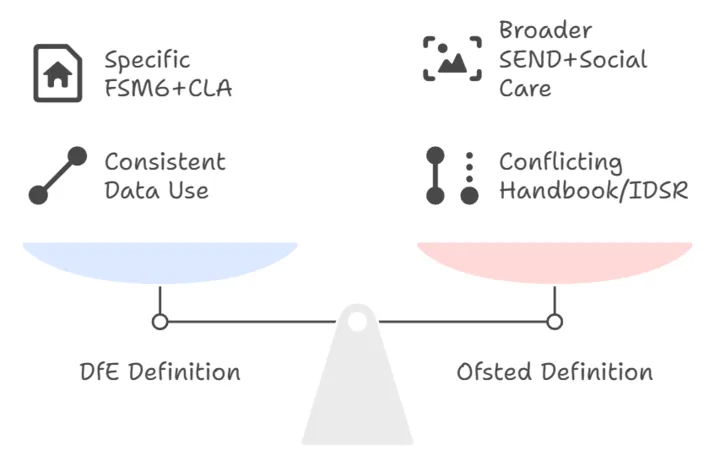
The term ‘disadvantaged’ is commonly used in education – especially by Ofsted and in school performance reports – but what does it mean? This blog post aims to shed some light on a subject that is evidently causing some confusion.
TMA (Too Many Acronyms)
There is a confusing array of terms and acronyms used to describe pupils from poorer backgrounds. A pupil might currently be on free school meals (FSM) or may have been on free school meals in the last 6 years (FSM6). It’s possible that their period of free school meals may have been even further back, in which case they could be coded as ‘FSM Ever’. Pupils that have been in receipt of free school meals in the last 6 years will attract the pupil premium (PP), unless they are – or have ever been – in care, in which case the school will receive the Pupil Premium Plus (PP+) uplift. This was made more confusing by the introduction of universal free school meals for key stage 1 pupils, which obviously does not come with the pupil premium attached.
Then, around a decade ago, we started seeing the phrase ‘disadvantaged pupils’ appear in various reports and sources of data, and now it has become commonplace. The DfE do not tend to refer to pupil premium as a group or characteristic – pupil premium is the funding that disadvantaged pupils receive. The problem with the term disadvantaged is: it’s ambiguous and can mean different things to different people. If you were to stop someone in the street and ask them to describe a disadvantaged pupil, you’d probably get a wide range of responses – and it’s not much clearer in schools. Unlike the terms FSM or Pupil Premium – which have specific meanings – ‘disadvantaged’ could refer to anything that may act as a barrier to learning or development.
But disadvantaged – at least as far as the DfE are concerned – does have a specific meaning. It refers to pupils that have been on free school meals in the last 6 years (FSM6) or have been in care at any point (CLA/LAC). These are the pupils in receipt of the Pupil Premium and Pupil Premium Plus; it does not include service children, who receive a lower rate of Pupil Premium. It is this definition that is widely used in school performance reports found in the Analyse School Performance (ASP) system, Explore Education Statistics (EES), and the public school performance tables.
A lack of consistency
All would be fine if the term was consistently applied but it hasn’t been. The outgoing Ofsted School Inspection Handbook – used in inspections since 2019 – states that:
‘the term ‘disadvantaged pupils’ is used to mean: pupils with special educational needs and/or disabilities (SEND); pupils who meet the definition of children in need of help and protection; pupils receiving statutory local authority support from a social worker; and pupils who otherwise meet the criteria used for deciding the school’s pupil premium funding (this includes pupils claiming free school meals at any point in the last 6 years, looked after children (children in local authority care) and/or children who left care through adoption or another formal route)‘
Inspectors will therefore have a much broader definition of disadvantaged, which includes pupils with SEND and those known to social care. Of greater concern is the fact that this definition clashes with that used for the Inspection Data Summary Report (IDSR), which follows the narrower definition used by the DfE for accountability measures (i.e. FSM6+CLA). This means that two Ofsted documents – the handbook and the IDSR – had contrasting definitions of disadvantaged pupils. Inspectors, looking at performance data relating to disadvantaged pupils in the IDSR, could therefore assume that the group – perhaps flagged as significantly above or below average for attainment or progress – includes pupils that it doesn’t.

Barriers to learning
We now have the freshly revised Inspection Toolkit, and the confusion continues. But there is a change! Rather than rolling all the groups together under the banner of disadvantaged – as in the previous handbook – the various characteristics are now presented as a list, which is repeated throughout the document. The following is from the Inspection Information for State Funded Schools:
Throughout the inspection, we give particular attention to the experiences and outcomes of disadvantaged pupils, pupils with special educational needs and/or disabilities (SEND), pupils known or previously known to children’s social care and those who face other barriers to their learning and/or well-being. These groups are central to planning, inspection activity and evaluation.
Disadvantaged is therefore separate and distinct from SEND (although many pupils will appear in more than one group, of course). A better umbrella term may be ‘vulnerable pupils’ or ‘pupils with barriers to learning’ – schools are going to need to decide what those barriers are, and be able to flag them in their systems. It is worth noting that the word ‘barriers’ appears 81 times in the Ofsted Toolkit, at the time of writing.
In summary, the term ‘disadvantaged pupil’ has a specific definition – it is a pupil that has been on free school meals in the last 6 years or has been in care at some point. We should stick with that definition so that it matches the methodology of school accountability measures in the various performance reports (including IDSR). When we want to include other groups of pupils, we should use other terms to avoid confusion.
I hope that helps.

Leave a Reply